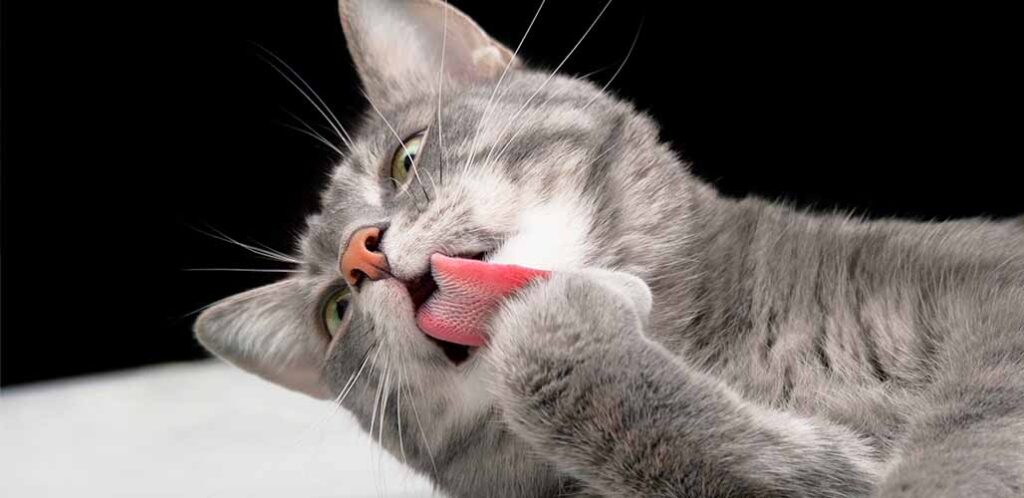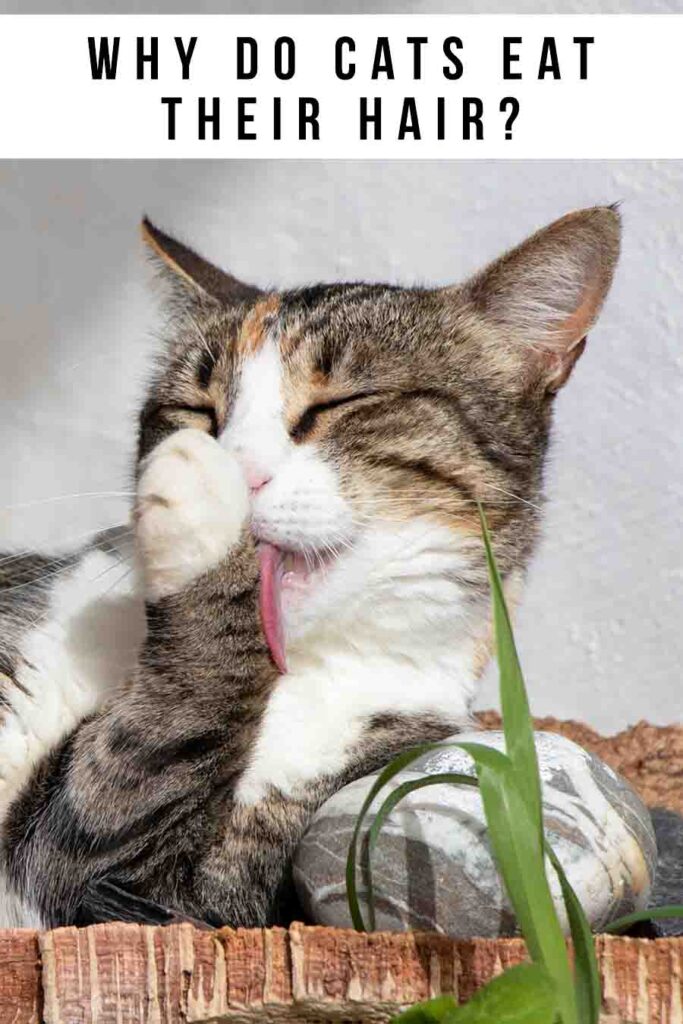
Cats have plenty of habits which appear perplexing or inexplicable to us. ‘Why do cats eat their hair?’ is one such riddle. I know one long haired cat who makes a particularly lip-smacking performance of swallowing shed hairs as he washes himself. In fact, all felines consume large volumes of fluff as a by product of grooming, but breaking off and eating excessive amounts of fur can also be a sign of an underlying medical or behavioral problem. Knowing what’s normal for your cat, and seeking veterinary attention of the amount of hair they eat goes beyond normal, is important for their welfare. Here’s everything you need to know about the reasons cats eat their own hair, and what to do about it.
Contents
- Why do cats eat their hair?
- Signs your cat is consuming too much hair
- Reasons cats start over-eating hair
- Are some breeds more likely to eat their hair than others?
- Potential consequences of eating too much hair
- How to stop your cat eating their hair
Why do cats eat their hair?
Eating their hair doesn’t offer cats any nutritional value, but nonetheless it’s a completely normal and almost universal behavior (the only notable exceptions of course being the hairless breeds like Sphynxes). Veterinarians and behaviorists estimate that our cats spend anything from a quarter to a half of their waking hours washing and grooming – in excess of three and a half hours a day, at least!
In the video above, you can see how cats use a nibbling action with their teeth and lick with their tongue to dislodge dirt and loose hair. The loose hairs are lifted out of their coat by backwards-facing barbs on their tongue, and since these barbs effectively prevent the hairs being spat out too, the only direction they can really go in is further backwards, down their throat. Inevitably, cats naturally end up consuming large volumes of hair as a consequence of their daily grooming routine, and then poop it out again without any discomfort. About one quarter of shorthaired cats and three quarters of long haired cats will also regurgitate at least one fur ball a year to get rid of hair they have swallowed.
Signs your cat is consuming too much hair
Even though it’s normal for cats to eat a lot of their hair in the process of washing, it’s still possible for them to eat too much hair. Signs that your pet is started ingesting an abnormal and unhealthy amount of fur include:
- Bringing up fur balls more frequently than usual.
- Large quantities of fur obviously visible in their poop.
- Thin or bald patches in their coat.
Keep in mind that an increase in furballs or hair visible in their poop could also be due to changes in gastrointestinal activity. In other words, the amount of hair they are eating has not changed, but its normal passage through the digestive tract has. This is equally in need of veterinary attention.

Reasons cats start over-eating their hair
There are lots of potential reasons for cats to eat more hair than is usual or normal. They fall broadly into three categories:
- Itchy skin conditions
- Pain, anxiety or stress
- Behavioral reasons
Itchy skin conditions
Cats tend to respond to medical problems which cause itchiness by grooming more, which inevitably increases how much hair they end up swallowing. Itchy skin complaints include:
- Parasites like fleas and demodex mange.
- Fungal skin infections like ringworm.
- Bacterial skin infections.
- An allergic reaction to something in their food or the environment.
Pain, anxiety or stress
Cats frequently groom themselves more as a coping mechanism if they are in pain, stress, or anxious. This can be due to changes in their routine or environment (such as a new pet or baby arriving, or a house move) or the result of pretty much any disease or injury. Stress and anxiety could also be brought on by boredom or loneliness.
Behavioral reasons for cats eating their hair
Very occasionally, eating their own hair is a more intrinsic behavior, which is not brought on by a skin condition, or obviously connected to triggers like stress or pain. This is known as psychogenic barbering, psychogenic mowing, or psychogenic alopecia. It’s not a well known condition, but some connections have been observed, such as an increased frequency of psychogenic barbering in cats which were weaned early. This kind of hair eating has been likened to obsessive compulsive disorder (OCD), and in some cases it might even have a genetic cause. Diagnosis is achieved only by ruling out everything else first, and the problem is usually lifelong (although it can be managed).
Are some breeds more likely to eat their hair than others?
Cats with long hair, such as Persians and Maine Coons, generally end up swallowing more hair than short coated cats. This is simply because the volume of their coat is greater. Oriental cat breeds like Siamese and Birman cats are significantly more likely than other breeds to display psychogenic barbering and hair eating. It is thought that the number of cases reported in oriental breeds points to a genetic cause. Since many of the affected cats also have an unusually high appetite, it could be that these cats have a feline version of pica in humans – an eating disorder which causes an powerful appetite for non-food items.
Consequences of cats eating too much hair
Under normal conditions, cats are able to transport quite large amounts of hair through their digestive system and into the litterbox without any ill-effects. But if they start eating too much hair, it can overwhelm their digestive tract, causing blockages or inflammation of the gut lining. Furthermore, if your cat nibbles away too much fur from the same place on their body, the exposed skin underneath is more vulnerable to risks like sunburn.
How to stop your cat eating their hair
First of all, it’s important to remember that eating hair in the process of grooming themselves is normal for cats, and doesn’t require any sort of intervention. However, if your cat’s behavior has changed, and there are indications they’re swallowing too much hair, ask your vet for advice. They will start by ruling out medical causes. This might include performing a skin biopsy for infections, or putting your pet on a restricted diet to identify allergies. If they find a medical cause, they will recommend a suitable course of treatment.
For over grooming without a medical cause, they might recommend one or more of:
- Pheromone diffusers like Feliway to reduce anxiety.
- Increasing environmental enrichment with toys, games, and other stimuli.
- Brushing their coat more often to remove loose hair for them.
In very severe cases, clipping might be appropriate to reduce a long haired cat’s coat to a manageable volume.
Why do cats eat their hair? Summary
Cats eat a lot of hair in the normal course of grooming themselves. Most cases of overgrooming have an underlying medical cause which has caused itchy skin or pain. Therefore, it’s important to visit a vet for help to resolve the problem. Let us know how you get on in the comments box down below!
Leave a Reply